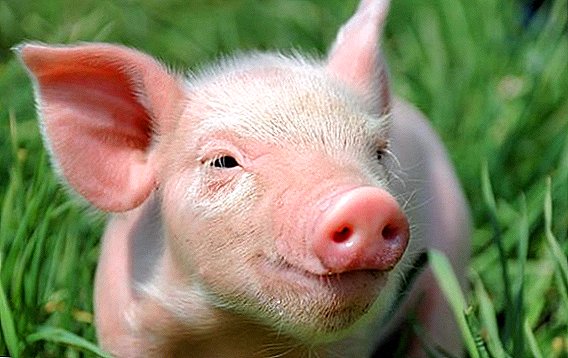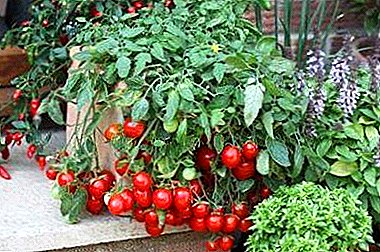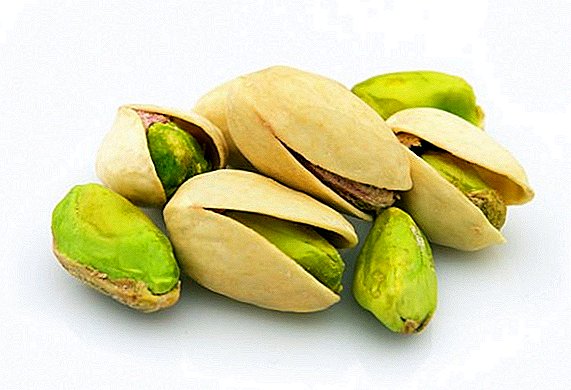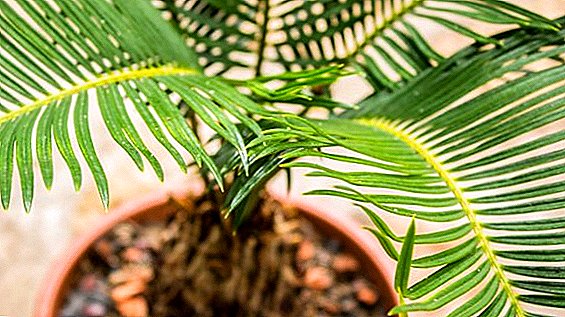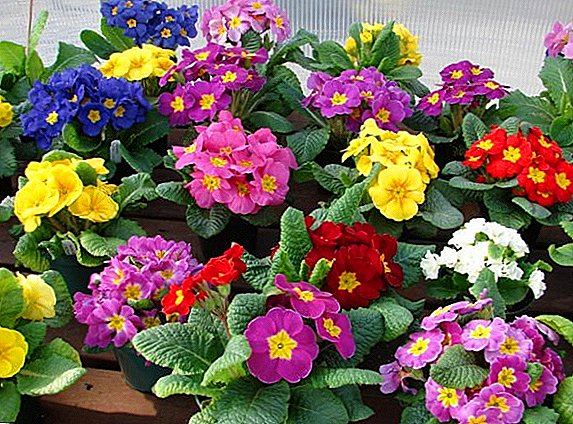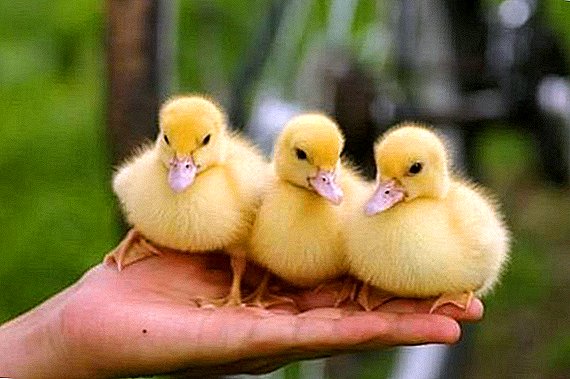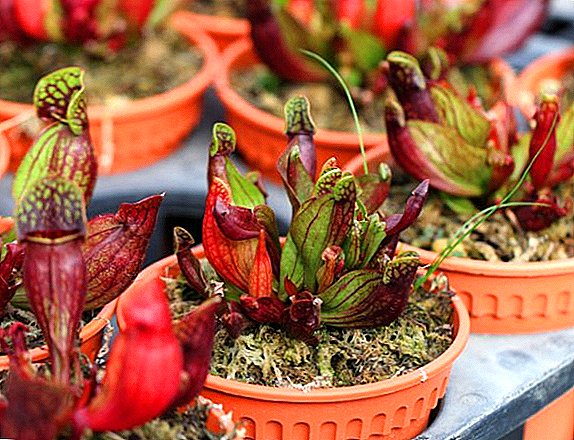 Sarrasenia is a very interesting representative of the flora. This is a predatory plant that looks extremely beautiful and extravagant.
Sarrasenia is a very interesting representative of the flora. This is a predatory plant that looks extremely beautiful and extravagant.
Unusual flower from America is a trap for insects that feeds on. At the same time, sarration can be successfully grown in our latitudes.
Choosing a place for sarration
Sarracenia is an exotic plant, and not every place in the apartment will suit her. The plant requires certain conditions for successful growth and development. 
Temperature and humidity
Temperatures from zero to 35 ° C are suitable for hardy carnivorous sarration. For example, a constant temperature of 10 ° C is suitable for a safe wintering. Similarly, the increased humidity of sarration is not required - it is enough to provide it with a level of 35-40%. For a plant it is much more important that the substrate be moistened in the tank where it grows.
Did you know? On sarration, growing in natural conditions, birds and even frogs can parasitize, taking out insects caught from a trap from its “traps”. On the other hand, an excess of prey can ruin a flower, and such “parasites” happen to appear very opportunely.
Lighting
The sun of sarrazenia loves; it is able to withstand direct sunlight, and even the hottest - midday, because in its natural environment it lives just in the sun. Despite its carnivorous addictions, sarrasenia remains a plant with all its inherent features - so, thanks to the green-colored parts, it performs photosynthesis. For favorable growth, the flower will need the clearest place in the apartment - on the south or west side.  The plant must be provided with an 8-10 hour day light. If not enough natural light - it is necessary to apply artificial. In summer, it is very good to take sarrasenia to the balcony, veranda, to the garden. However, there is no point in abusing transfers: it is very bad at turning or changing places.
The plant must be provided with an 8-10 hour day light. If not enough natural light - it is necessary to apply artificial. In summer, it is very good to take sarrasenia to the balcony, veranda, to the garden. However, there is no point in abusing transfers: it is very bad at turning or changing places.
Did you know? In Canada, this predatory flower has many names: it is called "soldier's circle" and "devil's shoe", "ancestral bowl" and "jug".
The choice of dishes or container for planting
The capacity for sarration must be chosen in which it is possible to ensure the moisture and drainage of the substrate. These can be plastic or glass pots with large drainage holes so that excess water can flow freely. Pots made of ceramics or other porous materials are not suitable - they tend to absorb moisture. 
Soil for sarration
Natural conditions for sarration are swamps, lakeside, or rivers. On her own plot she will like near the pool or pond. For planting at home, you can use a ready-made substrate intended for predatory plants, the acidity level of which is 4.5-6 pH.
You can prepare the ground for the predator yourself:
- equal parts of peat (it can be taken in two parts) and perlite, which is soaked in distilled water for two weeks, replacing it twice;
- 4 parts of peat, 2 parts of perlite and 1 part of sand;
- 4 parts of peat, 2 parts of sphagnum moss, 2 parts of sand, some charcoal.
Did you know? In fact, the sarrasenia traps - as, indeed, of other predatory plants - are not at all their flowers, but modified leaves.
Planting, reproduction and transplant sarrasenii
If sarration occurs in favorable conditions, its root system develops quickly enough, and the flower requires regular transplantation - annual or every two years.  Replant better after a period of rest in early spring.
Replant better after a period of rest in early spring.
- Two days before the procedure it will be useful to treat the plant with Epin in the proportion of 4-5 drops per cup of water.
- In the process of transplanting, dry and damaged leaves are removed and the roots are soaked, removing excess soil from them.
- Putting the drainage layer on the bottom of the tank prepared in advance, pour the substrate into it, moisten it and plant the plant in the hole made, deepening it by 3-4 cm.
- Planted flower watered and put on the place where he will be constantly.
- The transplanted plant is watered daily until fully engrafted.
Vegetative method
Vegetative reproduction is practiced after the plant reaches a certain size, so that it can be divided into a bush without harm to it. If you multiply too young or immature bush, sarraseniya becomes shallow and may even die. In the process of transplanting the bush is divided into two delenki, and each of them is planted in a separate container. 
Important! At one time it is not recommended to divide the sarration more than in two, so as not to weaken and destroy it.
Seed method
You can propagate this amazing plant with seeds, sowing them in a Petri dish or a similar container, and subsequently diving into a pot.
- Without fail, the seeds must be stratified for one to two months. Without this procedure, they probably will not ascend.
- A day before planting, they are soaked in warm water.
- Seeds are placed in a container with a mixture of quartz sand and peat moss, moistening it with a spray bottle. You can sprinkle them a little on top.
- Crops must be covered with a film or glass and put the container in a place where the temperature is maintained at 23-28 ° C.
- It must be ventilated once every two to three days, maintaining a constant moisture content of the substrate.
- When shoots appear, the glass or film is removed.
- A young sarrasenia needs a 16-hour light day. If it cannot be provided naturally, a phytolamp is required.
 Sprouts will be ready at the time of transplantation in about a year, as they grow rather slowly. Young growths are transplanted into the substrate for an adult predatory plant, using small pots 7–9 cm in diameter.
Sprouts will be ready at the time of transplantation in about a year, as they grow rather slowly. Young growths are transplanted into the substrate for an adult predatory plant, using small pots 7–9 cm in diameter.Did you know? Sarracenia and other predators prefer reproduction in a vegetative way, since insects that can pollinate them are eaten with appetite. The only bird that is able to cope with this task is hummingbirds, so they don’t hurry to part with the seed method.
Plant Care
It is not difficult to take care of sarracenium, but it differs from the usual one that applies to most houseplants. There are nuances that must be considered. 
Watering sarratsenii
Sarracenia loves water, because it lives on the banks of reservoirs. If you landed this predator on the bank of the pond in your area, then you do not need to water it. A flower planted in a pot needs to be watered with water — distilled or filtered in such a way as to remove minerals and salt. Distilled water can be purchased at a gas station or in the auto shop, as well as at the pharmacy.
Check out the list of various predatory plants.
Watering is carried out from a pallet in which water must always be present in a decent amount, about half the level of the pot. It is necessary that the substrate never dries out, except for hibernation. But even then it should be watered once a week, not allowing full drying. 
Fertilizer and dressing
If your sarratseniya dwells in the fresh air, it does not need to be fed. She is able to take care of herself and get food that will satisfy her nutritional needs. You can offer her a suitable meal once, a maximum of twice a month.
Important! Sarratseniyu should never be fed with fertilizers for plants - they can destroy a flower that receives all the necessary things from its prey.
The predator growing in "captivity" requires additional feeding:
- small insects;
- earthworms;
- bloodworm and so on.

You need to feed the plant, which formed mature trap leaves. If your flower does not cover the trap with an umbrella, it is necessary to pour distilled water in half to a tubular jug and to stimulate active growth, add ants to the diet, feeding the animal once a month for several live insects.
Important! Sarracenia should not be given meat, fish or dead insects.
Wintering sarration
All types of sarration are required winter respite, which lasts 3-4 months. Wintering sarratsyeny need for a long existence, as well as for the implementation of its own natural cycle, in particular - the possibility of flowering.  The plant should be kept in a cool room with a temperature of 0 to 10 ° C. It can comfortably spend the winter, for example, in the vegetable compartment of a refrigerator. At the same time, the intensity of irrigation is sharply reduced, and the main task for this period is to prevent the substrate from drying out. Weekly moisturizing is enough for this.
The plant should be kept in a cool room with a temperature of 0 to 10 ° C. It can comfortably spend the winter, for example, in the vegetable compartment of a refrigerator. At the same time, the intensity of irrigation is sharply reduced, and the main task for this period is to prevent the substrate from drying out. Weekly moisturizing is enough for this.
Pests and diseases of sarration
Although sarration and carnivorous, it is susceptible to diseases typical of plants:
- gray rot can especially roam during the winter period: it is required to remove the areas affected by it, to eliminate staleness and to treat the plant with a fungicide preparation;
- root rot provokes excessive watering and / or insufficient drainage: it is necessary to urgently transplant a flower and adjust watering;
- if the place where the plant is located is low humidity and high temperature, you may one day find aphid, mealybug or spider mite: they are washed off with a soap solution, removing the damaged parts of the plant, treated with an insecticidal preparation, regulate the temperature and humidity indicators.
Read about unusual colors such as sundew, passionflower, nepentes, orchis, hoya, camellia and amorphophallus.
In addition, sarration may suffer from improper care:
- when a flower is dark, its leaves turn yellow, dry - they dry out;
- if the plant overwintering incorrectly, it may not bloom, moreover, begin to shed leaves.
Thus, the overseas guest is easy to grow in a regular city apartment. It is not so difficult to take care of this exotic, incredibly beautiful and very original flower, one has only to learn the simple rules of care and maintenance.


